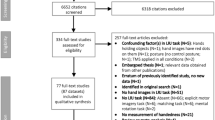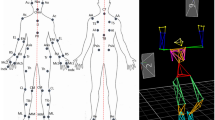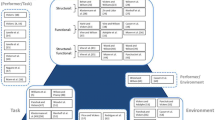Abstract
We investigated strategies of healthy elderly participants (74–84 years old) during prehension and transport of an object with varying degrees of fragility. Fragility was specified as the maximal normal force that the object could withstand without collapsing. Specifically, kinetic and kinematic variables as well as and force covariation indices were quantified and compared to those shown by young healthy persons (19–28 years old). We tested three hypotheses related to age-related changes in two safety margins (slip safety margin and crush safety margin) and indices of force covariation. Compared to young controls, elderly individuals exhibited a decrease in object acceleration and an increase in movement time, an increase in grip force production, a decrease in the correlation between grip and load forces, an overall decrease in indices of multi-digit synergies, and lower safety margin indices computed with respect to both dropping and crushing the object. Elderly participants preferred to be at a relatively lower risk of crushing the object even if this led to a higher risk of dropping it. Both groups showed an increase in the index of synergy stabilizing total normal force produced by the four fingers with increased fragility of the object. Age-related changes are viewed as a direct result of physiological changes due to aging, not adaptation to object fragility. Such changes in overall characteristics of prehension likely reflect diminished synergic control by the central nervous system of finger forces with aging. The findings corroborate an earlier hypothesis on an age-related shift from synergic to element-based control.




Similar content being viewed by others
References
Arbib MA, Iberall T, Lyons D (1985) Coordinated control programs for movements of the hand. Exp Brain Res Suppl 10:111–129
Booth FW, Weeden SH, Tseng BS (1994) Effect of aging on human skeletal muscle and motor function. Med Sci Sport Exerc 26:556–560
Brooks SV, Faulkner JA (1994) Skeletal muscle weakness in old age: underlying mechanisms. Med Sci Sport Exerc 26:432–439
Burstedt MK, Flanagan JR, Johansson RS (1999) Control of grasp stability in humans under different frictional conditions during multidigit manipulation. J Neurophysiol 82:2393–2405
Cole KJ (1991) Grasp force control in older adults. J Mot Behav 23:251–258
Cole KJ, Beck CL (1994) The stability of precision grip force in older adults. J Mot Behav 26:171–177
Cole KJ, Rotella DL, Harper JG (1999) Mechanisms for age-related changes of fingertip forces during precision gripping and lifting in adults. J Neurosci 19:3238–3247
Comaish S, Bottoms E (1971) The skin and friction: deviations from Amonton’s law and the effects of hydration and lubrication. Br J Dermatol 8:37–43
Cooke JD, Brown SH, Cunningham DA (1989) Kinematics of arm movements in elderly humans. Neurobiol Aging 10:159–165
Dinse HR (2006) Cortical reorganization in the aging brain. Prog Brain Res 157:57–80
Doherty TJ, Vandervoort AA, Brown WF (1993) Effects of aging on the motor unit: a brief review. Can J Appl Physiol 18:331–358
Eisen A, Entezari-Taher M, Stewart H (1996) Cortical projections to spinal motoneurons: changes with aging and amyotrophic lateral sclerosis. Neurology 46:1396–1404
Erim Z, Beg FM, Burke DT, De Luca CJ (1999) Effects of aging on motor-unit control properties. J Neurophysiol 82:2081–2091
Flanagan JR, Tresilian J (1994) Grip-load force coupling: a general control strategy for transporting objects. J Exp Psych Hum Percept Perf 20:944–957
Flanagan JR, Wing AM (1993) Modulation of grip force with load force during point-to-point arm movements. Exp Brain Res 95:131–143
Flanagan JR, Wing AM (1995) The stability of precision grip forces during cyclic arm movements with a hand-held load. Exp Brain Res 105:455–464
Fradet L, Lee G, Dounskaia N (2008) Origins of submovements in movements of elderly adults. J Neuroeng Rehabil 5:28
Francis KL, Spirduso WW (2000) Age differences in the expression of manual asymmetry. Exp Aging Res 26:169–180
Gelfand IM, Latash ML (1998) On the problem of adequate language in motor control. Mot Control 2:306–313
Gilles MA, Wing AM (2003) Age-related changes in grip force and dynamics of hand movement. J Mot Behav 35:79–85
Gorniak SL, Zatsiorsky VM, Latash ML (2007a) Hierarchies of synergies: an example of two-hand, multifinger tasks. Exp Brain Res 179:167–180
Gorniak SL, Zatsiorsky VM, Latash ML (2007b) Emerging and disappearing synergies in a hierarchically controlled system. Exp Brain Res 183:259–270
Gorniak SL, Zatsiorsky VM, Latash ML (2009a) Hierarchical control of prehension. I. Biomechanics. Exp Brain Res 193:615–631
Gorniak SL, Zatsiorsky VM, Latash ML (2009b) Hierarchical control of prehension. II. Multi-digit synergies. Exp Brain Res 194:1–15
Gorniak SL, Zatsiorsky VM, Latash ML (2010) Manipulation of a fragile object. Exp Brain Res 202:413–430
Grabiner MD, Enoka RM (1995) Changes in movement capabilities with aging. Exerc Sport Sci Rev 23:65–104
Hamill J, Selbie WS (2004) Three-dimensional kinematics. In: Robertson DGE et al (eds) Research methods in biomechanics. Human Kinetics, Champaign, pp 35–52
Johansson RS, Westling G (1984) Roles of glabrous skin receptors and sensorimotor memory in automatic control of precision grip when lifting rougher or more slippery objects. Exp Brain Res 56:550–564
Kang N, Shinohara M, Zatsiorsky VM, Latash ML (2004) Learning multi-finger synergies: an uncontrolled manifold analysis. Exp Brain Res 157:336–350
Kapur S, Friedman J, Zatsiorsky VM, Latash ML (2010a) Finger interaction in a three-dimensional pressing task. Exp Brain Res 203:101–118
Kapur S, Zatsiorsky VM, Latash ML (2010b) Age-related changes in the control of finger force vectors. J Appl Physiol 109:1827–1841
Kinoshita H, Francis PR (1996) A comparison of prehension force control in young and elderly individuals. Eur J Appl Physiol 74:450–460
Latash ML, Li S, Danion F, Zatsiorsky VM (2002a) Central mechanisms of finger interaction during one- and two-hand force production at distal and proximal phalanges. Brain Res 924:198–208
Latash ML, Scholz JP, Schöner G (2002b) Motor control strategies revealed in the structure of motor variability. Exerc Sport Sci Rev 30:26–31
Latash ML, Scholz JP, Schöner G (2007) Toward a new theory of motor synergies. Mot Control 11:276–308
Levinson DJ (1978) Seasons of a man’s life. Knopf, New York
Lindberg P, Ody C, Feydy A, Maier MA (2009) Precision in isometric precision grip force is reduced in middle-aged adults. Exp Brain Res 193:213–224
Mackenzie CL, Iberall T (1994) The grasping hand. North Holland, Amsterdam
Olafsdottir H, Yoshida N, Zatsiorsky VM, Latash ML (2007a) Elderly show decreased adjustments of motor synergies in preparation to action. Clin Biomech 22:44–51
Olafsdottir H, Zhang W, Zatsiorsky VM, Latash ML (2007b) Age-related changes in multi-finger synergies in accurate moment of force production tasks. J Appl Physiol 102:1490–1501
Olafsdottir HB, Kim SW, Zatsiorsky VM, Latash ML (2008) Anticipator synergy adjustments in preparation to self-triggered perturbations in elderly individuals. J Appl Biomech 24:175–179
Oldfield RC (1971) The assessment and analysis of handedness: the Edinburgh inventory. Neuropsychologia 9:97–113
Park J, Sun Y, Zatsiorsky VM, Latash ML (2011) Age-related changes in optimality and motor variability: an example of multi-finger redundant tasks. Exp Brain Res (in press)
Pataky TC, Latash ML, Zatsiorsky VM (2004) Prehension synergies during nonvertical grasping, I: experimental observations. Biol Cybern 91:148–158
Rodgers MA, Evans WJ (1993) Changes in skeletal muscle with aging: effects of exercise training. Exerc Sport Sci Rev 21:65–102
Savescu AV, Latash ML, Zatsiorsky VM (2008) A technique to determine friction at the fingertips. J Appl Biomech 24:43–50
Schieber MH (2001) Constraints on somatotopic organization in the primary motor cortex. J Neurophysiol 86:2125–2143
Schieber MH, Santello M (2004) Hand function: peripheral and central constraints on performance. J Appl Physiol 96:2293–2300
Seidler-Dobrin RD, He J, Stelmach GE (1998) Coactivation to reduce variability in the elderly. Mot Control 2:314–330
Shim JK, Lay B, Zatsiorsky VM, Latash ML (2004) Age-related changes in finger coordination in static prehension tasks. J Appl Physiol 97:213–224
Shim JK, Latash ML, Zatsiorsky VM (2005) Prehension synergies in three dimensions. J Neurophysiol 93:766–776
Shinohara M, Latash ML, Zatsiorsky VM (2003a) Age effects on force produced by intrinsic and extrinsic hand muscles and finger interaction during MVC tasks. J Appl Physiol 95:1361–1369
Shinohara M, Li S, Kang N, Zatsiorsky VM, Latash ML (2003b) Effects of age and gender on finger coordination in MVC and sub-maximal force-matching tasks. J Appl Physiol 94:259–270
Shinohara M, Scholz JP, Zatsiorsky VM, Latash ML (2004) Finger interaction during accurate multi-finger force production tasks in young and elderly persons. Exp Brain Res 156:282–292
Sun Y, Zatsiorsky VM, Latash ML (2011) Prehension of half-full and half-empty glasses: time and history effects on multi-digit coordination. Exp Brain Res 209:571–585
Teulings HL, Contreras-Vidal JL, Stelmach GE, Adler CH (1997) Parkinsonism reduces coordination of fingers, wrist, and arm in fine motor control. Exp Neurol 146:159–170
SKM V, Zatsiorsky VM, Latash ML (2010) Variance components in discrete force production tasks. Exp Brain Res 205:335–349
Verillo RT (1979) Change in vibrotactile thresholds as a function of age. Sens Process 3:49–59
Walker N, Philbin DA, Fisk AD (1997) Age-related differences in movement control: adjusting submovement structure to optimize performance. J Gerontol B Psychol Sci Soc Sci 52:P40–P52
Welford AT (1984) Between bodily changes and performance: some possible reasons for slowing with age. Exp Aging Res 10:73–88
Wing AM, Flanagan JR, Richardson J (1997) Anticipatory postural adjustments in stance and grip. Exp Brain Res 116:122–130
Winges SA, Eonta SE, Soechting JF, Flanders M (2009) Effects of object compliance on three-digit grasping. J Neurophysiol 101:2447–2458
Zatsiorsky VM (1998) Kinematics of human motion. Human Kinetics, Champaign
Zatsiorsky VM, Latash ML (2004) Prehension synergies. Exerc Sport Sci Rev 32:75–80
Zatsiorsky VM, Latash ML (2008) Prehension synergies: an overview. J Mot Behav 40:446–476
Zatsiorsky VM, Li ZM, Latash ML (1998) Coordinated force production in multi-finger tasks: finger interaction and neural network modeling. Biol Cybern 79:139–150
Zatsiorsky VM, Li ZM, Latash ML (2000) Enslaving effects in multi-finger force production. Exp Brain Res 131:187–195
Zhang W, Olafsdottir HB, Zatsiorsky VM, Latash ML (2009) Mechanical analysis and hierarchies of multidigit synergies during accurate object rotation. Mot Control 13:251–279
Acknowledgments
The study was supported in part by NIH grants AG-018751, NS-035032, and AR-048563. We would like to thank Jason Friedman and Jim Metzler for their assistance in data collection, Shweta Kapur and Varadhan SKM for their assistance in subject recruitment and screening, and Matthew Kuklis for help with editing this manuscript. Additionally, we would like to thank PCB Piezotronics (Depew, NY, USA) for donating the accelerometer used in this study.
Author information
Authors and Affiliations
Corresponding author
Rights and permissions
About this article
Cite this article
Gorniak, S.L., Zatsiorsky, V.M. & Latash, M.L. Manipulation of a fragile object by elderly individuals. Exp Brain Res 212, 505–516 (2011). https://doi.org/10.1007/s00221-011-2755-3
Received:
Accepted:
Published:
Issue Date:
DOI: https://doi.org/10.1007/s00221-011-2755-3




